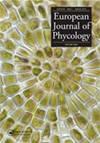Phosphate affects susceptivity of Sarcodia suae to arsenate
IF 1.7
4区 生物学
Q2 MARINE & FRESHWATER BIOLOGY
引用次数: 1
Abstract
ABSTRACT Algal susceptivity to inorganic arsenate As(V) is linked to the plant nutrient phosphate due to their similar uptake processes. This study determines the response of Sarcodia suae to three phosphate concentrations (1, 10 and 20 mg l–1) when exposed to As(V) (0, 250 µg l–1) for 7 days. The parameters measured include growth, pigments (Chlorophyll a (Chl a), allophycocyanin (APC), phycocyanin (PC), phycoerythrin (PE), total phycobiliproteins (TPBP) and carotenoids), inorganic arsenic (iAs), and total arsenic (TAs) uptake behaviour and bioaccumulation capacity. The growth rate showed significant differences among treatments. Significantly higher levels of pigments including Chl a and carotenoids were observed with an increase in external phosphate concentrations. On the other hand, APC, PC, PE and TPBP showed no significant differences among treatments. The trend of iAs and TAs uptake when phosphate is high suggests competition between phosphate and As(V) as is evident from the reduction of uptake with increased phosphate. The depletion of phosphate and As(V) in the medium also suggests accumulation by the algae. In addition, S. suae was considered an As accumulator but not a hyperaccumulator as defined on its bioaccumulation capacity of 48 and 97 mg kg–1 of iAs and TAs, respectively. Overall, these findings suggest that environmental factors including levels of phosphate have a key role in developing effective As bioremediation in the environment. Highlights Phosphate in Sarcodia suae probably regulates arsenic uptake. Photosynthetic pigments can be linked to competitive mechanisms of As(V). The red alga Sarcodia suae is a candidate for As wastewater treatments by Bioconcentration Factor analysis.磷酸盐对酸腐藻对砷酸盐敏感性的影响
藻类对无机砷酸盐As(V)的敏感性与植物养分磷酸盐的吸收过程相似。本研究确定了在暴露于砷(V)(0,250µg l-1) 7天后,水藻对三种磷酸盐浓度(1,10和20 mg l-1)的反应。测定的参数包括生长、色素(叶绿素a (Chl a)、异藻蓝蛋白(APC)、藻蓝蛋白(PC)、藻红蛋白(PE)、总藻胆蛋白(TPBP)和类胡萝卜素)、无机砷(iAs)和总砷(TAs)的吸收行为和生物蓄积能力。不同处理间生长速率差异显著。随着外部磷酸盐浓度的增加,包括Chl a和类胡萝卜素在内的色素水平显著提高。APC、PC、PE和TPBP在不同处理间差异不显著。当磷酸盐含量高时,iAs和TAs的摄取趋势表明磷酸盐和As(V)之间存在竞争,这一点从随着磷酸盐含量的增加而减少的摄取中可以看出。培养基中磷酸盐和As(V)的耗竭也表明藻类的积累。此外,s.s suae的iAs和TAs的生物蓄积量分别为48和97 mg kg-1,因此被认为是As蓄积体,而不是超蓄积体。总的来说,这些发现表明,环境因素包括磷酸盐水平在环境中开发有效的As生物修复中起关键作用。水肉瘤中的磷酸盐可能调节砷的吸收。光合色素可能与砷(V)的竞争机制有关。通过生物富集因子分析,发现水红藻是砷废水处理的候选藻类。
本文章由计算机程序翻译,如有差异,请以英文原文为准。
求助全文
约1分钟内获得全文
求助全文
来源期刊

European Journal of Phycology
生物-海洋与淡水生物学
CiteScore
4.80
自引率
4.20%
发文量
37
审稿时长
>12 weeks
期刊介绍:
The European Journal of Phycology is an important focus for the activities of algal researchers all over the world. The Editors-in-Chief are assisted by an international team of Associate Editors who are experts in the following fields: macroalgal ecology, microalgal ecology, physiology and biochemistry, cell biology, molecular biology, macroalgal and microalgal systematics, applied phycology and biotechnology. The European Journal of Phycology publishes papers on all aspects of algae, including cyanobacteria. Articles may be in the form of primary research papers and reviews of topical subjects.
The journal publishes high quality research and is well cited, with a consistently good Impact Factor.
 求助内容:
求助内容: 应助结果提醒方式:
应助结果提醒方式:


